new posts in all blogs
Viewing: Blog Posts Tagged with: Paper &, Most Recent at Top [Help]
Results 1 - 7 of 7
How to use this Page
You are viewing the most recent posts tagged with the words: Paper & in the JacketFlap blog reader. What is a tag? Think of a tag as a keyword or category label. Tags can both help you find posts on JacketFlap.com as well as provide an easy way for you to "remember" and classify posts for later recall. Try adding a tag yourself by clicking "Add a tag" below a post's header. Scroll down through the list of Recent Posts in the left column and click on a post title that sounds interesting. You can view all posts from a specific blog by clicking the Blog name in the right column, or you can click a 'More Posts from this Blog' link in any individual post.

By:
Melissa Wiley,
on 4/13/2016
Blog:
Here in the Bonny Glen
(
Login to Add to MyJacketFlap)
JacketFlap tags:
Photos,
Family Adventures,
Nature Study,
Midori,
Assorted and Sundry,
Paper & Desk,
papery days,
bullet journal,
travelers notebook,
Add a tag
Actually, I guess the first couple of photos here are from March. (1) We hadn’t been to Old Town San Diego in a while and made a quick pilgrimage there one day during Wonderboy’s spring break. (2) Rilla’s bunny chain—entirely her own design—is the best Easter decoration I’ve seen in a long time. Those ears!
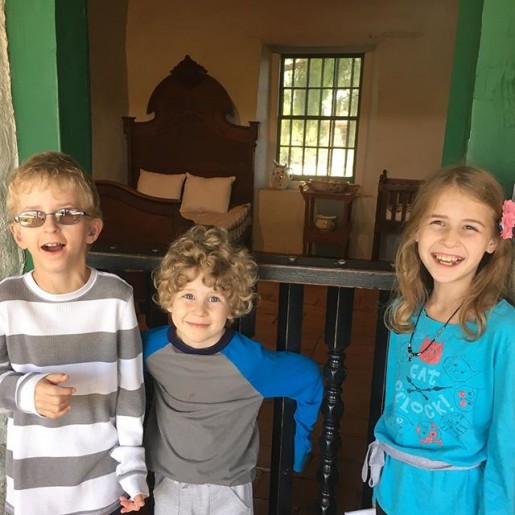
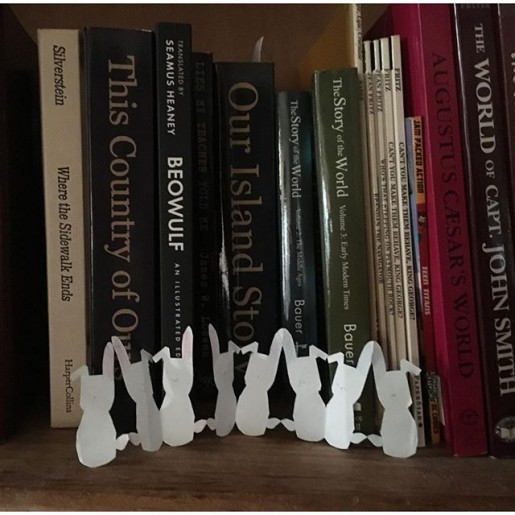
April for real:
(3) How Huck likes to rock his Math-U-See.
(4) Library day. I want that Eric Carle rug!
(5) Another library-day shot. What I love most about this photo is that the bed they’re on belongs to neither of them. It’s Beanie’s—the bottom bunk, which has long been the favorite place for my girls to sprawl. Beanie, meanwhile, does most of her own sprawling on Rilla’s bed. Go figure.
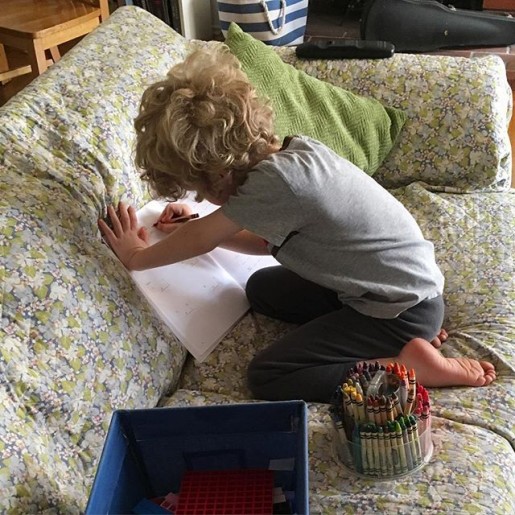
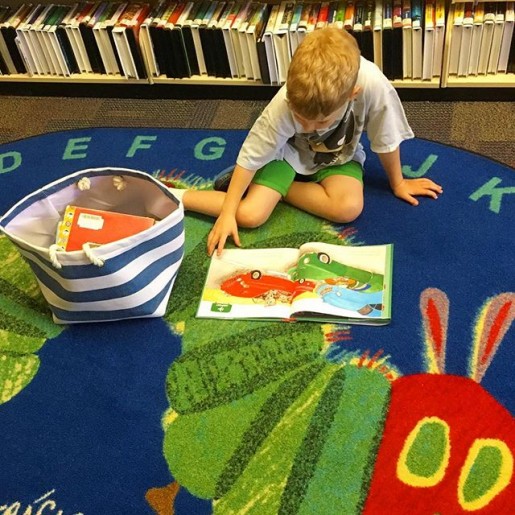
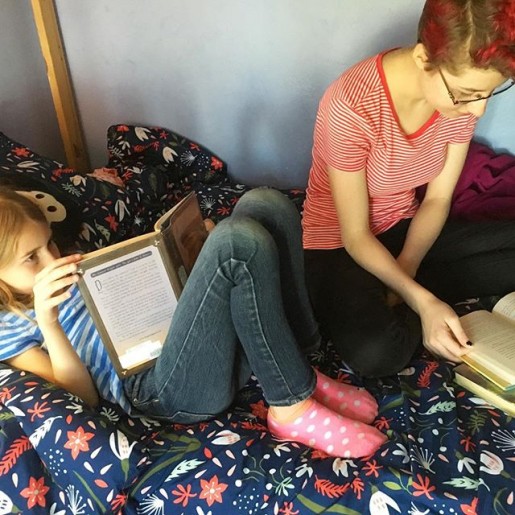
(6) Monarch caterpillar on our milkweed: always a sight that brings me joy.
(7) Wonderboy raised these sunflowers from a handful of old seeds spilled in the bottom of a bag of mostly-empty seed packets. The color surprised us!
(8) Also a surprise this year: the giant blooms on a neglected rosebush by our patio. Loads of them! It’s like Valancy went at the bush with her clippers.

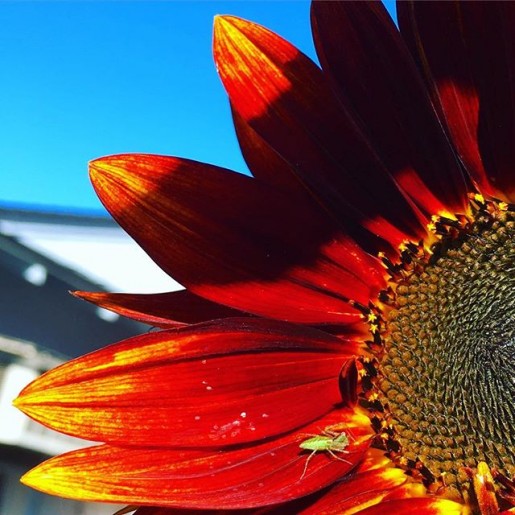
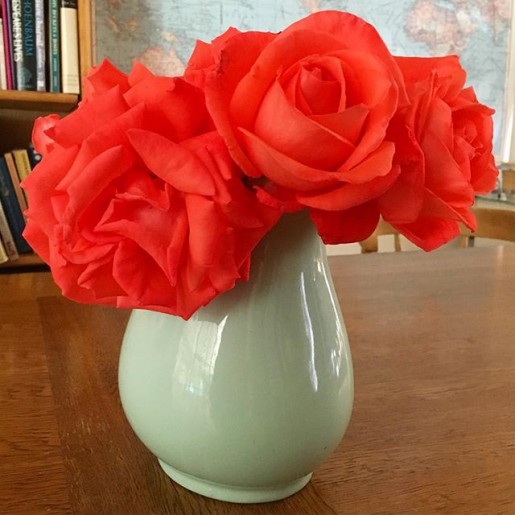
(9) Playing with a Hobonichi Techo-style layout in my bullet journal. Mary Ann Scheuer and I had a fun Skype session last week to chat about my bujo system. What’s working these days: Separate books for my messy notes and my bullet lists. It’s sort of a left brain/right brain thing: I need a space for scribbly notes of all kinds, an unkempt, all-purpose thinking-on-paper space; but I also need nice, neat(ish) to-do lists with boxes I can fill in as I accomplish tasks. It took me a LOT of years—and the revelation of the multiple-insert traveler’s notebook—to figure this out: that I need the two separate spaces.
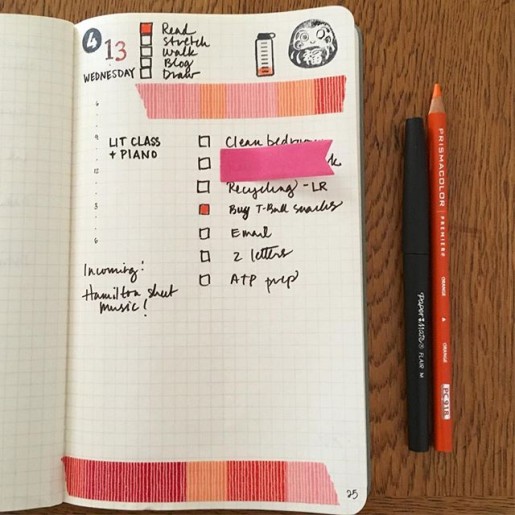
Yay, now I can fill in that ‘blog’ box!

By:
Melissa Wiley,
on 3/21/2016
Blog:
Here in the Bonny Glen
(
Login to Add to MyJacketFlap)
JacketFlap tags:
Assorted and Sundry,
Paper & Desk,
bullet journal,
Jane LaFazio,
lupines,
Photos,
Art,
Butterflies,
Nature Study,
Monarch butterflies,
watercolors,
Miss Rumphius,
Add a tag

By:
Melissa Wiley,
on 3/10/2016
Blog:
Here in the Bonny Glen
(
Login to Add to MyJacketFlap)
JacketFlap tags:
Organization,
moleskine,
sketchbook,
fountain pens,
planning,
Household,
planners,
Nerd,
Midori,
Lesley Austin,
Paper & Desk,
Homeschool Record-Keeping,
travelers notebook,
Lamy,
Add a tag
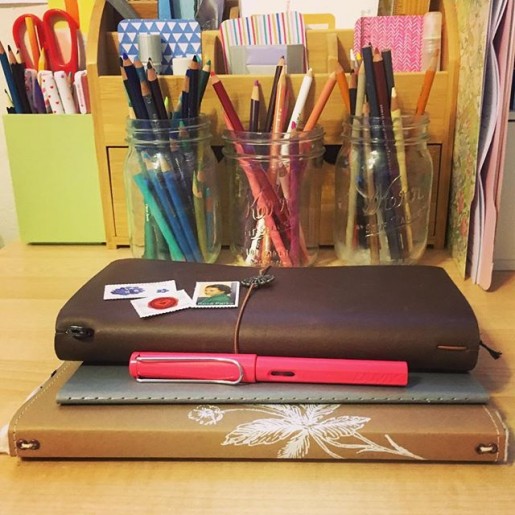
My everyday favorites. After a year of experimenting, I’ve got my system figured out. Top to bottom:
• Midori Travelers Notebook for my monthly calendar, weekly journal, and a scribble notebook;
• Moleskine Cahier for daily to-lists (bullet journal);
• Wild Simplicity Daybook for homeschooling notes and records (including our weekly Shakespeare lines—we learn monologues two lines at a time); and
• the Lamy Safari fountain pen my family gave me for my birthday. (LOVE.) (That’s an Amazon affiliate link but if you’re buying pens in the U.S., you should order from the nice people at Goulet Pen Company. Their instructional videos are invaluable, their customer service is top notch, and they offer inexpensive ink samples so you can try out all sorts of gorgeous colors. And that is not an affiliate link. I’m just a happy customer.)
I still keep the family appointments on Google Calendar, but I enjoy writing everything out in the TN monthly calendar (#017) as well. I use the horizontal weekly TN insert (#019) for chronicling the day after it happens—just a few notes about highlights. For the last several months I’ve used a blank TN insert (#003) for my bullet journal but came to realize I need a separate space for scrawling, sketching, doodling, working things out on paper. If I do that in the bullet, things get messy. WAY messy. So I’ve gone back to my old (cheaper) Moleskine grids for task lists.
The Midori travels with me everywhere; the bullet journal lives on my desk where I do most of my work; and the Daybook has a home in a basket by my rocking chair in the living room.
I’m laughing at how complicated this must seem if you aren’t a pen-and-paper fanatic…but I juggle a lot of roles (and kids) and I find having different paper spaces helps me keep things straight.
More nitty gritty:
I also have a kraft folder (#020) in my Midori to tuck ephemera and snail-mail supplies into. Since I started carrying notecards and stamps around, I’ve gotten much more prompt with my thank-you notes.
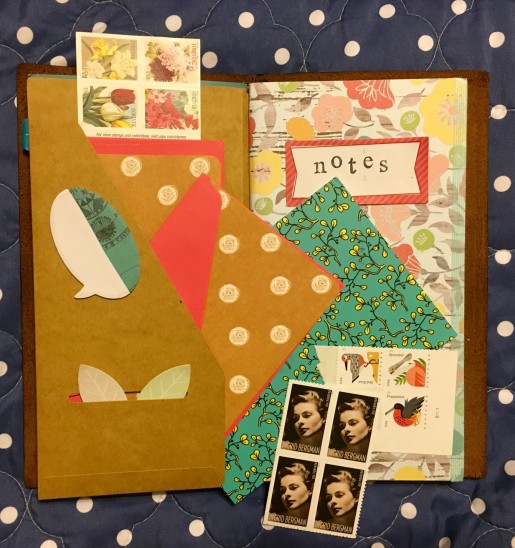
• I love the feel of Prismacolor colored pencils on the paper Lesley Austin uses in the Wild Simplicity Daybook. I’m sure I’ve raved about this before—the lovely creamy pencil on this recycled paper with just the right amount of tooth.
• Prismacolor pencils also delight me in the bullet journal: I like ’em for filling in my checkboxes.
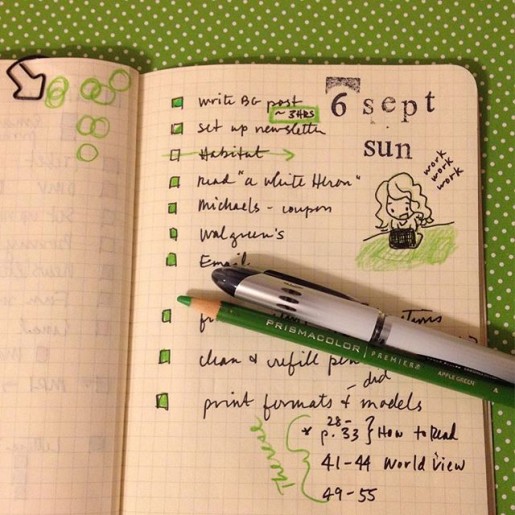
• This pic, which I’ve shared here before, shows my favorite way to organize a task list: to-do items on the right, and the verso is for related notes and numbers. I also keep a running “Nag List” on a sticky note that travels from spread to spread. It’s for important tasks that I might not get done today but I gotta deal with soon—like finishing my taxes or booking a doctor appointment. I consult it each evening when making out my bullet list for the next day.
• Sometimes I’ll tuck another insert into the Midori to be used for a specific purpose. For example, I keep a log of incoming and outgoing snail mail. I don’t like a superfat Midori, though, so more often that insert lives in my stationery pouch.
• As I mentioned, I do a lot of casual sketching in my blank Midori insert. I find I’m often more comfortable there than in my proper sketchbook, because it feels more casual. But I do have a couple of sketchbooks going and I try to work in at least one of them daily. One is a spiral-bound 7×10 Canson Mixed Media pad, which gets lukewarm reviews from real artists but I quite like its toothy paper—not to mention its price point when Michael’s has a good sale + coupon combo. You have to watch for it, but now and then they’ll give you a 20% off including sale items coupon during a buy-one-get-one-free sketchbook sale. My other sketchbook is a Moleskine Art Plus, and it’s…okay? I love its size and shape (fits nicely in my bag), but the paper is too smooth for my liking. I much prefer the feel of Moleskine’s watercolor sketchbook—a lovely texture to that paper. But so far I’ve mostly just used that for color charts.
• For sketching pens, I like Sakura Pigma Microns or my Pilot Metropolitan fountain pen (check out all the groovy colors at Goulet Pens) with Platinum Carbon ink, which is waterproof so it plays nice under watercolors. However, lately I’ve come to realize that what I enjoy most of all is sketching in pencil. I love the look of black or brown ink drawings, and most of the sketchbook artists I admire work directly in ink, but I really love the way a pencil feels on the paper. I keep hitting that point over and over, don’t I—the tactile experience matters more to me than how it looks.
Ha, this got long! Would you believe it was just going to be a quick copy-paste of something I tossed on Instagram today?

By:
Melissa Wiley,
on 12/31/2015
Blog:
Here in the Bonny Glen
(
Login to Add to MyJacketFlap)
JacketFlap tags:
Art,
journals,
sketchbook,
fountain pens,
pens,
art journals,
Midori,
Handwriting,
Assorted and Sundry,
Paper & Desk,
papery days,
travelers notebook,
Add a tag
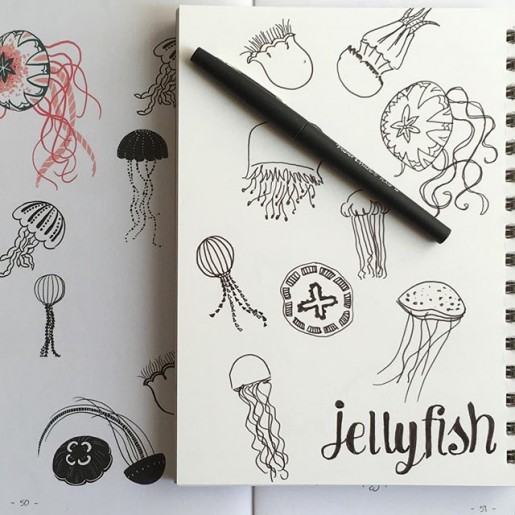
It started, I think, with my commitment to a daily sketching habit in the fall of 2014. By last January, the habit was firmly established, and I only missed a handful of days all year. January is also when I started taking “kourses” at Sketchbook Skool—which exposed me to not just the lessons and work of accomplished artists, but also to their media of choice. Which is to say: they have firm opinions about pens, making them my kind of people.
Putting pen to paper in my sketchbook reminded me how much I love that feeling. Now, I have never enjoyed doing large amounts of handwriting—I can’t write my books longhand, for example. My wrist aches after a couple of pages. But I love penmanship: other people’s, mainly. My handwriting is changeable and seldom neat. I never managed to commit to one way of shaping letters, so I wind up with different kinds of I and r and k all in one line. Last night I was numbering pages in a new bullet journal and realized that some of my 4s were the pointy kind and some were not. Happens all the time. I like change, y’all.

Anyway—I can’t write volumes by hand all at once, but I adore the feeling of a good pen on the right kind of paper. Experimenting with various pens (Pigma Micron, Le Pen, Pilot Metropolitan, Lamy Joy with 1.1 nib) reminded me how much I love analogue notetaking. So while I still find apps like Workflowy useful for tracking particular kinds of tasks, in the past few months I have shifted almost entirely to written notekeeping.
Notes on paper
Bullet journaling works very well for me. I’ve always kept a notebook as an idea and memory catch-all: phone call records, tasks completed, shopping lists, story ideas, doodles—it all winds up in the notebook in a giant jumble. Adding a bullet-journal-style index and page numbers was a revelation: now I can have my hodgepodge but find things later. Perfect.
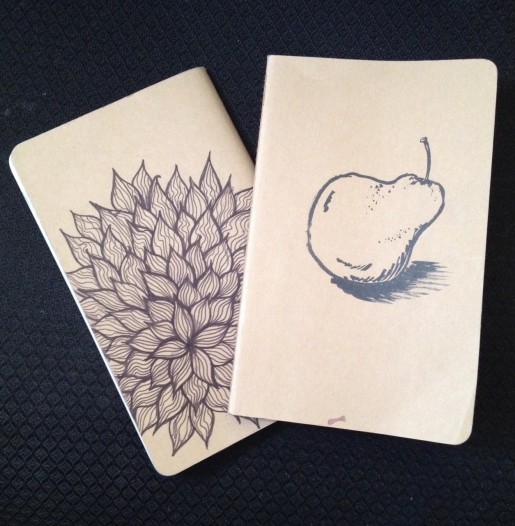
For the first part of this year I used kraft-brown Moleskine Cahiers. They’re just the right size for tucking in my bag, they’re sturdy enough to handle the beating I give them, and they fill up in a month or two which means the continual fresh start I love. Then, in August, a glorious friend surprised me with a Midori Traveler’s Notebook. It was love at first sniff. I mean, I. JUST. ADORE. THIS. THING.
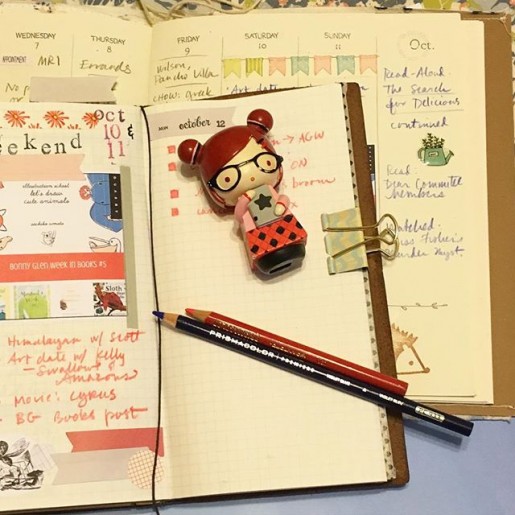
A traveler’s notebook, if you don’t know, involves a cover (usually leather, sometimes cloth or vinyl) that has a sturdy elastic cord or two strung through the spine. You slip a paper notebook under the cord to hold it in place. Then you can use additional bands to hold other inserts—various types of notebooks, folders, calendars, even plastic credit-card sleeves or zipper pouches.
My Midori set-up
After playing with my Midori for a month or two, I settled into the configuration that works best for me: a weekly calendar insert, a grid notebook, and a kraft folder that holds stickers, postage stamps, notepaper, and such. I keep a monthly calendar, too, but I don’t need to carry the whole year around with me so I have begun photocopying (and shrinking a bit) the current month and clipping that to my weekly page.

The blank grid insert is my bullet journal/idea repository/casual sketchbook, replacing the Moleskine Cahier. I number the pages and use the first page as an index, just as before. I like big fat checkboxes for my task lists, which I fill in with Prismacolor pencil as tasks are completed. Color is my happy place.  I also like to paste in ephemera and sometimes embellish with stamps, doodles, or washi tape. Basically, these inserts become collages of all the things that occupy my days and my mind. I seem to do a fair amount of sketching in them, too, even though I have an actual sketchbook for that purpose—I work in the real sketchbook daily but the TN grid insert is a low-pressure place to experiment, and I always have it with me.
I also like to paste in ephemera and sometimes embellish with stamps, doodles, or washi tape. Basically, these inserts become collages of all the things that occupy my days and my mind. I seem to do a fair amount of sketching in them, too, even though I have an actual sketchbook for that purpose—I work in the real sketchbook daily but the TN grid insert is a low-pressure place to experiment, and I always have it with me.
Thanks to Lesley Austin’s beautiful Wild Simplicity Daybook designs, I discovered that a week-on-two-pages spread is an excellent space for me to do some chronicling. I’ve posted before about how I use the Daybook for recording homeschooling and housekeeping notes. I really like having a separate space (and such a beautiful one) for those things. I wear so many hats, and I need ways to keep my roles sorted. The Daybook (visible under my Midori in a photo above), like all of Lesley’s paper goods, conveys a sense of peace and serenity, and so it has become a really nourishing space for me to jot down my notes about what the kids read, did, said. I always feel so happy when I open that book.
Taking a cue from that experience, I decided to try the Midori week-on-two-pages for my TN. The version I selected (Refill #19) has the week in seven horizontal boxes on the left page, and a grid page for notes on the right. I use Google Calendar for our family appointments and schedules, so a couple of times a week I open G-Cal and add any new appointments to the Midori insert. At the end of each day, I create an entry on the weekly calendar page, filling it with notes about what happened that day. It isn’t a to-do list, it’s more like a diary. Not what needs to be done (that’s what the bullet journal is for), but what I actually did. The facing page fills up with quotes, ephemera, drawings, and notes on things I’ve read or watched.
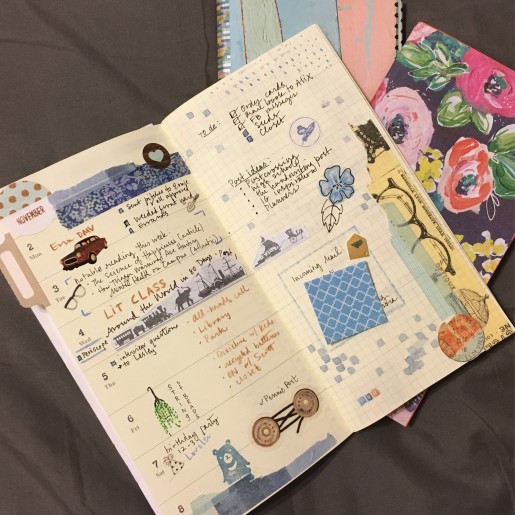
Since these pages serve as a kind of journal, I like to decorate them with washi, drawings, and watercolors. I wind up doing the ornamenting mostly on weekends. Often, I’ll start the week with two or three colors of washi in front of me, and that will set the tone for my week. This daily decorating is relaxing, it takes only moments, and I enjoy paging back through previous weeks.
So those are the two main TN inserts I carry around: the weekly calendar for journaling (more or less), and the grid notebook (Refill #2) for everything else. Those two inserts plus the kraft folder (Refill #20) make the Midori as fat as I like it to get. I could easily come up with uses for half a dozen more inserts (the TN’s capacity for letting you compartmentalize is its genius), but I found that I really prefer a non-chunky Midori.
However! I did decide to devote a single insert to all medical and health-insurance-related notes, and this has been one of my best moves ever. Instead of having those notes intermingled with everything else, they live in their own space now, with a list of phone numbers on the first page. I can tuck THAT insert into the Midori when we’re heading to an appointment. It’s perfect.
NEED MOAR PAPER
All this notebooking served to increase the satisfaction I was finding in putting pen to paper. And I found I was thinking about handwriting a lot. My little goddaughter sent me a thank-you note, and her mother’s handwriting on the envelope—the gorgeous, familiar handwriting that graced pages and pages of letters in the years after college when Krissy and I wrote to each other constantly—gave me a little jolt of joy and nostalgia. I hadn’t seen her writing in a while, and I missed it. I told her (via text, naturally) how happy I’d been to see her writing, and she said the same thing had happened to her when she saw my writing on the package I’d sent her daughter.
Shortly after that, I read that Atlantic article that was making the rounds about how the ballpoint pen killed cursive. Fascinating stuff, but the bit that grabbed me was this: “In his history of handwriting, The Missing Ink, the author Philip Hensher recalls the moment he realized that he had no idea what his good friend’s handwriting looked like. ‘It never struck me as strange before… We could have gone on like this forever, hardly noticing that we had no need of handwriting anymore.'”
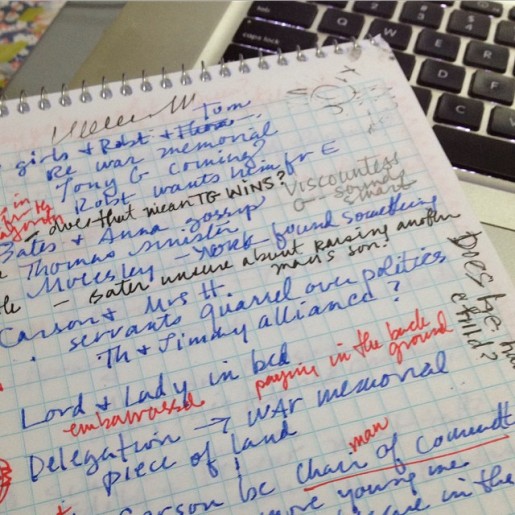
He had no idea what his good friend’s handwriting looked like. I miss handwriting, I thought. The distinct and beloved scripts of my old friends flashed before my eyes. I’d know those hands anywhere, could pick them out of any penmanship lineup. My kids probably won’t experience that. Jane has friends on the other side of the country she talks to via electronic means every single day, but they probably don’t know each other’s handwriting. I have plenty of friends myself whose writing I’ve never seen. If we met after 1995, chances are I’ve seen your handwriting seldom or never. (Tanita! What’s your writing like?)
Channeling my inner Jane Austen
The handwriting epiphany spurred me to the next phase of my analogue journey: I started writing letters again. Like, by hand. I have penpals in Denmark, France, Austria, and England, as well as various friends across the U.S.
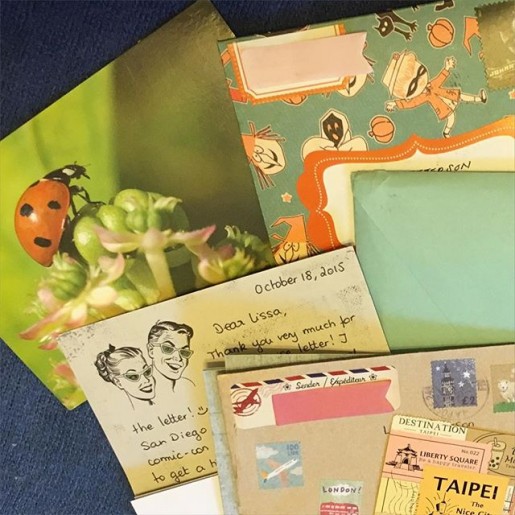
I’m amused and a little baffled that for so many years I thought of letters owing replies as a kind of guilt-ridden chore—I always took forever to answer, always had them nagging in the back of my mind. Because the truth is: snail mail is the cheapest fun around. Sure, they’re slower to write than email; slower to arrive than a Facebook message. But that’s part of the charm: the slowing down, the taking time. Just as many of us have (re)discovered the joys of slow reading in the past couple of years, I have found satisfaction in…what to call it? Not slow writing, really, because part of the point is that instead of waiting months or even (gulp) years to answer a letter, I now try to reply within three weeks; I guess what I’m enjoying isn’t about speed (or lack of it) after all. It’s about a tactile experience. The skritch of a fountain pen on flecked paper. The careful selection of stamps. The smoothing-out of a bit of washi tape across a seal. The rustle of envelopes as they slide into the box, slumbering before their journey to places I’ll never go.
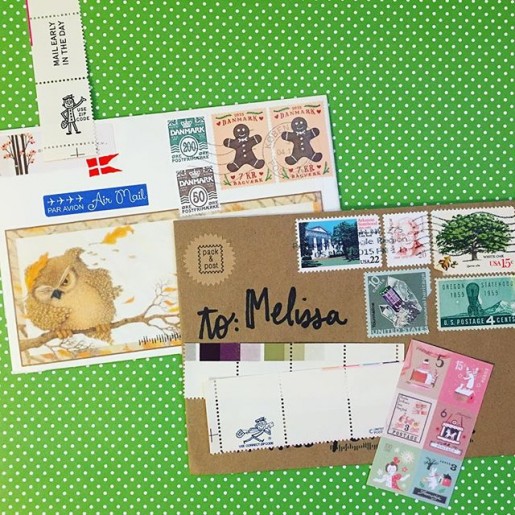
And best of all: the incoming letters. Foreign stamps, unfamiliar scripts, universal experiences. Beautifully decorated, many of them—it’s like getting mail from Griffin and Sabine. This one written at a café in Vienna; that one at a Starbucks in Portland. Kaleidoscopic glimpses of a life gradually resolving into a picture. We talk about things we could easily tell via email, but we’ve decided to let these stories take the scenic route. Some of them never arrive, or show up months later, ragged and stained. This only makes us love them more.
I’m writing to say I’ll write soon
A piece of the experience that affords me much merriment is the impulse, whenever a letter arrives, to hurry to Facebook and ping the friend who sent it. “Got your letter! Will reply soon,” I’ll write, and “Yay, can’t wait!” she’ll ping back. Never mind that the letter asks questions which could be more immediately answered via any of a dozen digital platforms. The answers will keep. Come Saturday afternoon, I’ll settle in with my cocoa, my envelopes, my wonderful new pink Lamy Safari that I got for my birthday. Which paper—the whimsical or the lovely? The fern stamps, or the Ingrid Bergmans? I’m almost out of globals, and the post office won’t have the new ones for a while. But have you seen them, the moons? I’m already imagining them on dark blue envelopes…
Our digital and analogue worlds will forever be intertwined, I believe. We’ll snap photos of our beautiful incoming mail to share on Instagram, hashtagged so our kindred spirits can find and enjoy it. We’ll trade addresses on Facebook. We’ll email to find out if that letter ever arrived. We’ll scour Etsy for traveler’s notebook inserts and stock up on ink at Goulet Pens. We’ll sign up for swaps on websites, and then anxiously check tracking to see when packages might arrive. We’ll reblog Tumblr articles about clever ways to hack a bullet journal. We’ll watch Youtube videos about how to set up a Midori and we’ll tap the heart button a zillion times during an unboxing on Periscope. We’ll link to photos of new USPS stamp releases in our blog posts. 
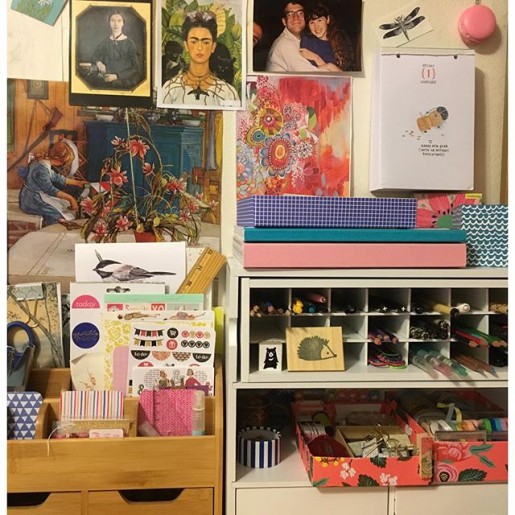
My blog, though, is perhaps the thing that suffered this past year as my attention shifted to paper and ink. I found that when I had a few quiet moments, I was more apt to want to spend them sketching or writing a letter than blogging. After ten years of a steady blog habit, that was a bit of a surprise. In January, this blog will be eleven years old. I’ve successfully figured out how to integrate my analogue and digital calendar-keeping and task-tracking, but it did take a little while for the pieces to settle into place. I expect the same will happen with blogging.
Happy New Year, friends!

By:
Melissa Wiley,
on 9/3/2015
Blog:
Here in the Bonny Glen
(
Login to Add to MyJacketFlap)
JacketFlap tags:
Organization,
Day Planners,
planners,
Midori,
things that make me swoon,
Lesley Austin,
Small Meadow Press,
Paper & Desk,
Daybooks,
Add a tag

As a member of Wisteria & Sunshine, Lesley Austin’s gentle online community for home-and-hearth inspiration, I’ve had the fun of watching behind the scenes as her beautiful new Wild Simplicity Daybook took shape. Today is a day to celebrate, because the Daybook has landed in her Etsy shop!

It’s a Midori-style cover made with the tender eco-friendly consciousness that suffuses all Lesley’s handmade wares, and she has created a selection of inserts to let you customize your Daybook for your own use. I’m particularly fond of Lesley’s monthly calendars (I’ve been using them in one form or another for almost a decade!), and her new weekly diary pages are the loveliest I’ve seen anywhere. She offers them in insert booklets spanning three months at a time, with the Autumn and Winter inserts currently available.
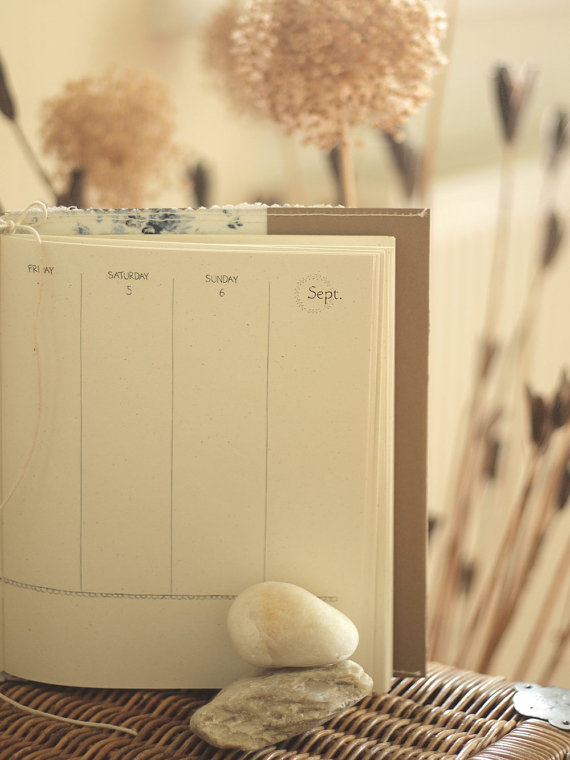
Besides the monthly and weekly calendar inserts, she is also offering blank inserts for notes or journaling and a “Days to Keep” booklet for recording birthdays, anniversaries, and other special dates.
This probably sounds like a sponsored post, but it isn’t! And Lesley didn’t ask me to write it. I am a longtime fan of her paper goods who has had the pleasure of becoming Lesley’s friend as well, and I’m so excited to see her latest venture take flight. Recently I was chatting with another friend about things we love, and I said, “I think my aesthetic is one part Waldorf kindergarten, one part library, and one part Small Meadow Press.” 

By:
Melissa Wiley,
on 8/11/2015
Blog:
Here in the Bonny Glen
(
Login to Add to MyJacketFlap)
JacketFlap tags:
organization,
homeschool,
Household,
Paper & Desk,
Homeschool Record-Keeping,
listmaking,
record-keeping,
task management,
WorkFlowy,
Add a tag
This is one of those posts that will likely only appeal to a few of you, but I thought it might be useful info for some. I’ve been test-driving a task management app called WorkFlowy this week. So far, so great, I gotta say.
I’ve mentioned before that I move back and forth between listkeeping and planning on paper and on the computer, sometimes tilted more one way than the other. I love my kraft-brown Moleskine Cahier grid journals for daily notes and bullet lists (and a whole lot of doodling), and I don’t see myself ever giving up paper altogether. Especially since I started putting an index on the first page, a la the bullet-journaling method. That simple step made instant coherence out of my mishmash of notes. I refer back to old notebooks frequently and now I can find the thing I’m looking for with relative ease.

So why do I use an online task list too? Isn’t that overkill? Not really, not the way I work. I need paper notebooks for a dumping ground, but the computer helps me stay streamlined and focused. For a long while, I was using a combo of Evernote and Remember the Milk (a to-do list app, quite a good one), as described in Mystie Winckler’s Paperless Home Organization. I still stash a lot of stuff in Evernote, but somewhere along the line I fell away from using RtM.
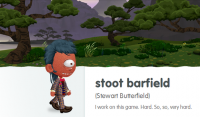 WorkFlowy caught my attention when I read that Stewart Butterfield’s team used it while building Slack. (I’m laughing at what a geek that sentence reveals me to be.) Stewart shall forever be known to us former and devoted Glitch players as Stoot Barfield. Before Glitch, he co-founded Flickr. Innovative guy. Slack has become my platform of choice for IM conversation with Scott and one or two other close friends I chat with often during the day. But that’s a topic for another post.
WorkFlowy caught my attention when I read that Stewart Butterfield’s team used it while building Slack. (I’m laughing at what a geek that sentence reveals me to be.) Stewart shall forever be known to us former and devoted Glitch players as Stoot Barfield. Before Glitch, he co-founded Flickr. Innovative guy. Slack has become my platform of choice for IM conversation with Scott and one or two other close friends I chat with often during the day. But that’s a topic for another post.
Anyway, I read about WorkFlowy and had to check it out for myself. It’s a streamlined, basic listmaking platform—and it’s marvelous.
It isn’t flashy. Just a simple list of bullet points in outline form, black text on a white screen. (There are a few other theme options, but none of them appeal to me.) You indent your bullets with the tab key, creating as many tiers as you like.
Here’s my basic list, collapsed so you only see the main topic categories.
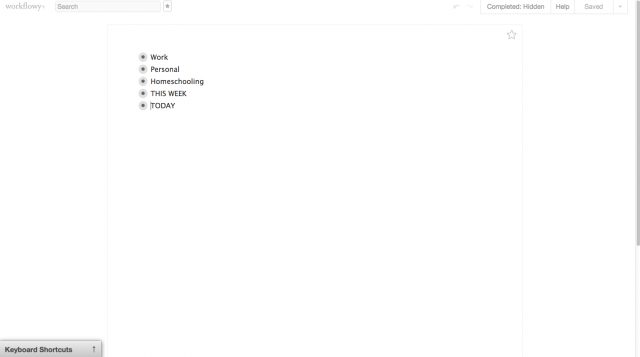
This image shows you my whole Workflowy tab because I wanted to show how uncluttered the interface is. I’ll crop the rest of my pictures so you can see the list up close.
Those are the five top-level categories I created, for now. (Remember, this is my first week with it.) “Work” and “Personal” are the top-level categories the tutorial suggests at the outset, and they seemed a good fit for me.
The grey circles around the bullet points mean there are entries under each one. Above is the collapsed view, hiding the rest of my outline. Let’s click to expand something.
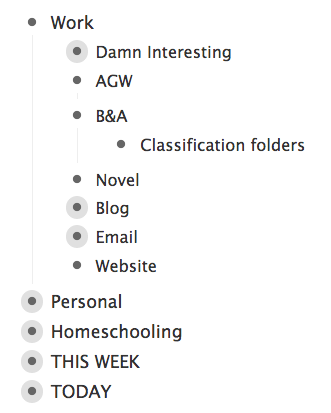
Here I’ve expanded the Work item, revealing various work subcategories I have created. My freelance clients, the novel I’m revising, and so on. I stuck my blog under work because it’s related to writing or editing, just like everything else on this section of the list.
So far, Personal is divided into subcategories like this:
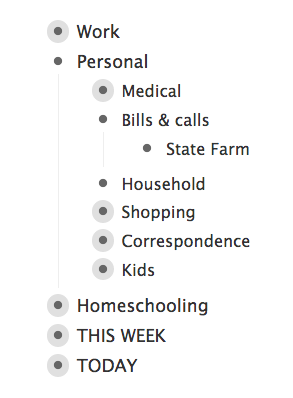
Under “Kids,” I have subcategories for each kid. (Workflowy calls them “children,” by the way—the subcategories, I mean, not my offspring. The top-level bullets are “parents.”) I’m finding this section particularly useful, a place to record who needs new shoes or has an activity coming up. It does have a bit of overlap with my Medical, Homeschooling, and Shopping categories, so as time goes on I may find I prefer to combine some of my sections.
You hover the mouse to the left of the bullet to pop up the collapse/expand option. Hovering over the bullet itself gives you a chance to mark the item complete, add a note, or other do other things with it, as you see in the popup.
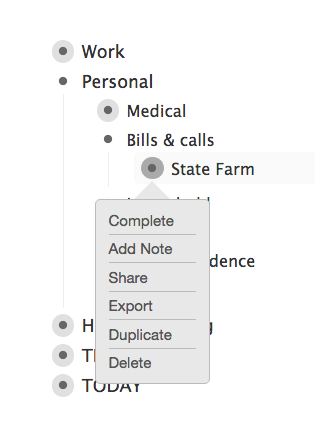
If you click on a bullet point, the switch to a view of just that one parent category and its children. Like this, when I click on the bullet next to “Homeschooling.”
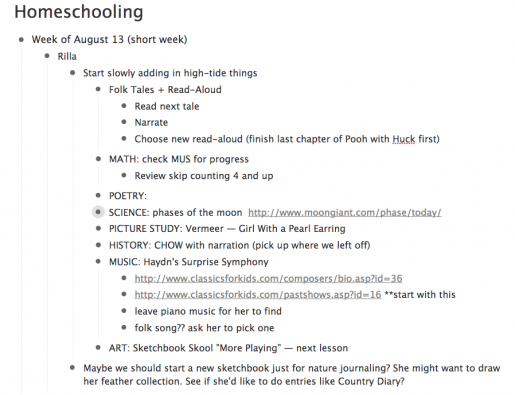
And here you see where I began to fall in love with Workflowy. It allows me to keep everything in one place—plans, lists, links, the works—and yet it’s not at all cluttered or busy. Even Evernote can’t match this ease of use, in my book.
HOMESCHOOLING TANGENT: Whenever we are beginning a new season of high tide, I tend to start off with pretty detailed lists of things to do, read, strew, and talk about. As the weeks roll on, I fall into a rhythm and can pretty much wing it, day to day. I’ll know what books we’re reading and what else I ought to be paying attention to.
I mention this because I don’t want to give the impression that I am THIS organized all the time.  Three or four weeks from now, I’ll more likely be jotting down what we did (past tense) at the end of a day rather than a plan-in-advance for what the day will bring. After so many years of rolling with the tides, I have a pretty good sense of how I work, and what works for us as a group. But August wouldn’t be August if I didn’t have some long lovely lists going on.
Three or four weeks from now, I’ll more likely be jotting down what we did (past tense) at the end of a day rather than a plan-in-advance for what the day will bring. After so many years of rolling with the tides, I have a pretty good sense of how I work, and what works for us as a group. But August wouldn’t be August if I didn’t have some long lovely lists going on.
(Oh, and re the Vermeer and Haydn entries: I’m drawing from the Harmony Fine Arts mini-unit. What a lovely and flexible resource!)
BACK TO WORKFLOWY. That image shows why I prefer onscreen planning for certain things. I do the same kind of thinking aloud, rearranging, and mind-changing on paper, but then of course I wind up with a page full of scratches and arrows. That Workflowy screenshot doesn’t show you how many things I altered after the first brain-dump. Shift + tab moves a bullet to the left, if you want to change its category level. (There’s a keyboard shortcut that allows you move things up or down, but it isn’t working for me. Supposed to be control + shift + arrow, but maybe it’s different for Mac? I haven’t bothered to look it up yet.)
ADORABLENESS TANGENT. The other day Rilla watched me copy and paste something with keyboard shortcuts. “Oh,” she remarked, “do you use Crickle-C too?” ::melt::
NO BUT SERIOUSLY, THIS POST IS ABOUT WORKFLOWY. You can toggle your view to Completed: Hidden if you want your finished tasks to disappear, or pop them back into view with Completed: Visible. (You can see the option up there in the first image, top right corner.) When visible, completed tasks are grayed out with a line through them. Highly satisfying.
You can also add tags! And then filter so only certain tags are showing! Beautiful feature. The search function in general is a most excellent addition to my to-do list process.
I added my THIS WEEK and TODAY categories to help prioritize stuff I really, really don’t want to let fall through the cracks. The hover-popup menu I showed above has a “duplicate” option, if you want something to appear in multiple places. This, too, could be highly useful for homeschool record-keeping or planning. Or menu-planning and so forth.
And that’s about all I’ve figured out in my first week of use.  There are a lot of video tutorials on the site to take you deeper. I think I’m only beginning to discover its applications. For example, there’s a “share” option that lets you share items with another user. So many possibilities for that! I can see using it with the older kids to keep track of who’s read what. Or we could share a shopping list, and when one of them needs something they add it and it pops up on my screen. That could be awesome.
There are a lot of video tutorials on the site to take you deeper. I think I’m only beginning to discover its applications. For example, there’s a “share” option that lets you share items with another user. So many possibilities for that! I can see using it with the older kids to keep track of who’s read what. Or we could share a shopping list, and when one of them needs something they add it and it pops up on my screen. That could be awesome.
Oh, and File > Print will put your list on paper.
There’s a mobile version too, of course, so all these lists can travel with you on your phone or tablet. I’m pleased with the interface so far, but I’ve spent most of my time on the desktop version.
I admit I’d love a theme option that allowed my text to be blue, red, or green on a white screen, but that’s a small complaint. The plain-jane version is fine.

By:
Melissa Wiley,
on 1/3/2014
Blog:
Here in the Bonny Glen
(
Login to Add to MyJacketFlap)
JacketFlap tags:
desk,
Household,
organizers,
Assorted and Sundry,
Evernote,
Paper & Desk,
Homeschool Record-Keeping,
Mystie Winckler,
Remember the Milk,
Add a tag
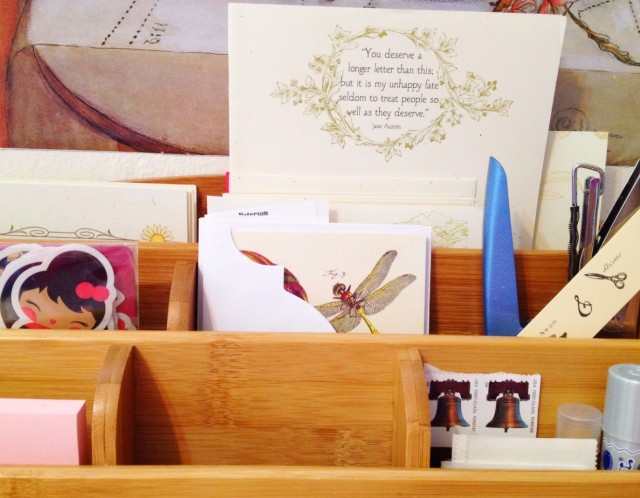
Really really really good tips in the Mystie Winckler book Pamela Barnhill recommends here, gang. I thought I was already using Evernote & Google Calendar efficiently, but I picked up some useful new ideas (including better integrating my systems) in the book. Which is 30% off with the code in Pam’s post. So, like, under $3.
In Paperless Home Organization, Mystie Winckler leads you through the process of using digital applications to build your very own paperless system. She walks you step-by-step through how to use four free apps to digitally store the same information you would normally keep in a home management binder.
Which means if you have a smartphone, or an iPod Touch, or any tablet, then your binder no longer sits cluttering up your counter, but in your hand – at the doctor’s office, the bookstore, even at your school room table.
I’d been meaning to try Remember the Milk—my pal Ron raves about it, and he doesn’t rave lightly—and Pam’s post, and Mystie’s book, nudged me to take the plunge. Last year I relied on TeuxDeux for daily task management, but my free trial period ran out and I decided I wasn’t enough in love with it to pay for it. It’s a really gorgeous, clean layout but too hard to go back to past days. Remember the Milk isn’t quite as visually appealing (its web app, that is; on my phone it’s quite nice) but it is so much more flexible and functional. Thanks to Paperless Home Organization, I’ve now got it talking to my Gmail account (my RTM to-do list pops up in my inbox sidebar) and WOW, this is just right for the way mah brain works.
As for Evernote, I rely on it for everything. Or so I thought. Now I see all sorts of new bits of recordkeeping I can shift over there. Very pleased.













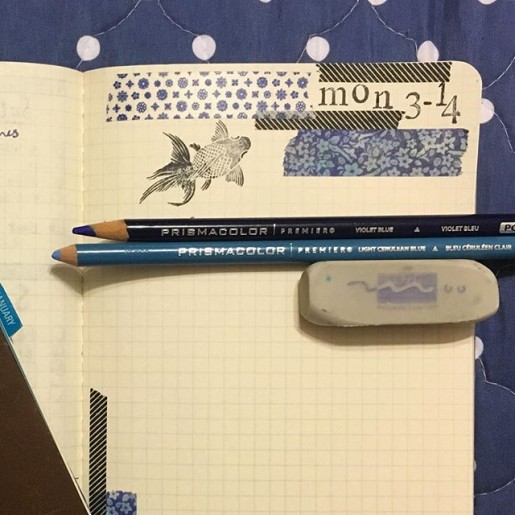
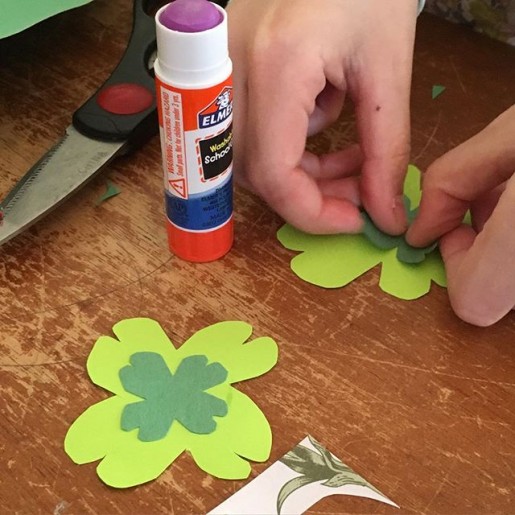

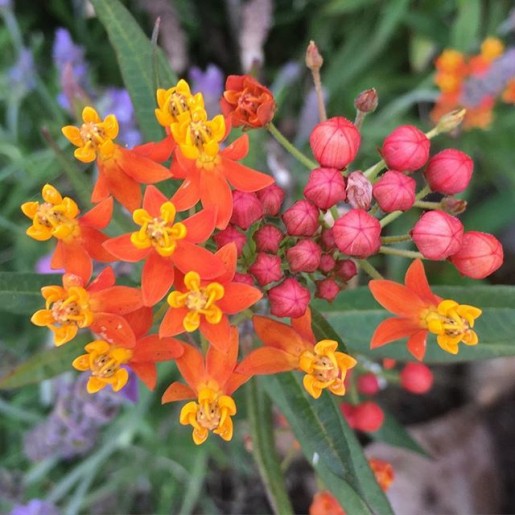

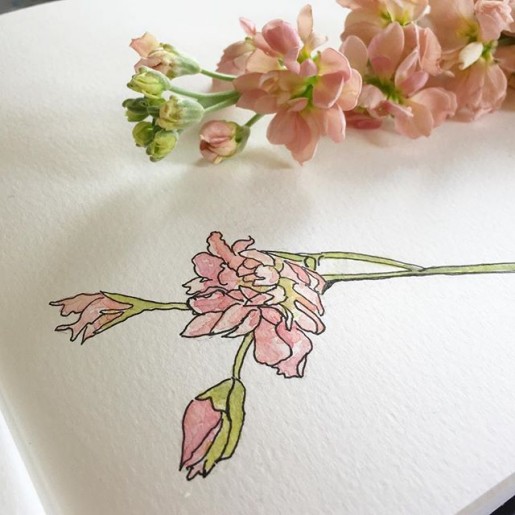
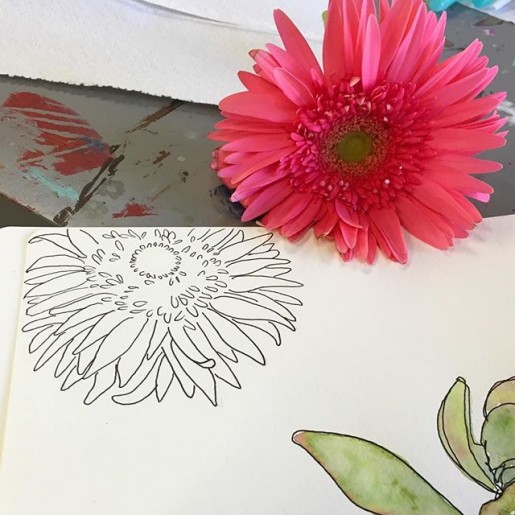
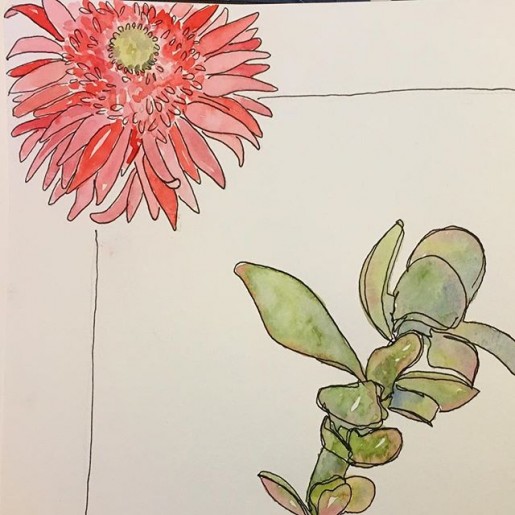
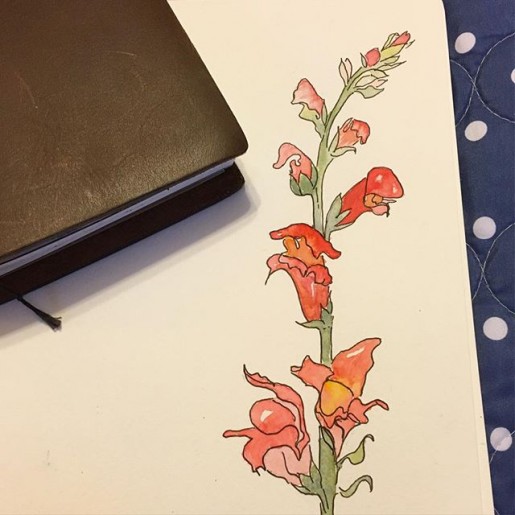







 I also like to paste in ephemera and sometimes embellish with stamps, doodles, or washi tape. Basically, these inserts become collages of all the things that occupy my days and my mind. I seem to do a fair amount of sketching in them, too, even though I have an actual sketchbook for that purpose—I work in the real sketchbook daily but the TN grid insert is a low-pressure place to experiment, and I always have it with me.
I also like to paste in ephemera and sometimes embellish with stamps, doodles, or washi tape. Basically, these inserts become collages of all the things that occupy my days and my mind. I seem to do a fair amount of sketching in them, too, even though I have an actual sketchbook for that purpose—I work in the real sketchbook daily but the TN grid insert is a low-pressure place to experiment, and I always have it with me.








 WorkFlowy caught my attention when I read that Stewart Butterfield’s team used it while building Slack. (I’m laughing at what a geek that sentence reveals me to be.) Stewart shall forever be known to us former and devoted Glitch players as Stoot Barfield. Before Glitch, he co-founded Flickr. Innovative guy. Slack has become my platform of choice for IM conversation with Scott and one or two other close friends I chat with often during the day. But that’s a topic for another post.
WorkFlowy caught my attention when I read that Stewart Butterfield’s team used it while building Slack. (I’m laughing at what a geek that sentence reveals me to be.) Stewart shall forever be known to us former and devoted Glitch players as Stoot Barfield. Before Glitch, he co-founded Flickr. Innovative guy. Slack has become my platform of choice for IM conversation with Scott and one or two other close friends I chat with often during the day. But that’s a topic for another post.




